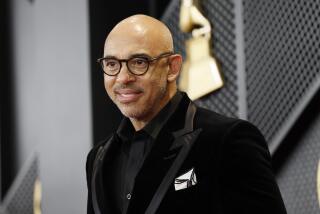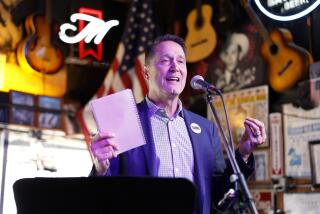RECORD INDUSTRY TRYING TO ALTER IMAGE
- Share via
Record company executives and civil rights groups agree that minorities are under-represented in the $4.5 billion a year music business. This is the first in an occasional series by Steve Pond, former West Coast music editor of Rolling Stone magazine, analyzing the problems and outlining attempted remedies.
When 36 minority teen-agers showed up at A&M; Records’ headquarters on La Brea Avenue just south of Sunset Boulevard last weekend to prepare for summer jobs in the music industry, they heard speeches and discussions peppered with words like opportunity, future and career.
Throughout the day of practical advice, jokes, pep talks and down-to-earth counseling, the youngsters never heard the words prejudice, discrimination or racism.
But while those phrases went unspoken, A&M;’s 11-week experiment--the record industry’s first major minority-hiring program--is bound to be watched closely in an industry that has been under increasing attack in recent months from critics who are charging discrimination in hiring and promotion.
Last March, the National Assn. for the Advancement of Colored People (NAACP) accused the record industry--where black artists are responsible for more than a quarter of the records sold--of being “virtually the sole preserve of white males.”
A&M; President Gil Friesen said that the company’s summer project, titled YES (Youth Employment Summer) to Jobs, had been in the works for months before the NAACP issued its charges at a Los Angeles press conference.
When he welcomed the youngsters to the A&M; lot Saturday morning, Friesen and his colleagues kept things light and friendly, causing controlled chaos when he asked the three dozen teen-agers to introduce themselves to one another and laughing when he learned that they were familiar with A&M; records mostly because of Janet Jackson’s recent hits.
“You know about the record business because of the records you buy and the music you hear on the radio,” Friesen said. “That’s one kind of talent in this business, and there’s no shortage of people who sing and perform. But there’s a shortage of another kind of talent, and that’s people to work in the record industry. . . . And that’s why you’re here.”
Months before the students at A&M; were given their first inside look at the record industry, several organizations, including the NAACP, the Black Music Assn. and the National Assn. of Black-Owned Broadcasters, were taking a close look at that industry--and they didn’t like what they saw.
The most comprehensive and critical report was the one released by the NAACP. Entitled “The Discordant Sound of Music,” it was based on an 18-month study and concluded that “by any objective measurement,” blacks are not receiving “a fair share of the economic opportunities generated by the industry.”
Said NAACP executive director Benjamin L. Hooks, “Equal opportunity is a myth and affirmative action is unknown. The record industry operates as a world unto itself, a closed society that sets its own rules and maintains a longstanding tradition of feasting on the talents of black artists and tossing crumbs from the table to other blacks.”
The report contained more specific complaints: that more money is available to promote white recording artists, that even some major black artists fail to use their clout to provide opportunities for other black professionals and, crucially, that having separate departments for black music and white music means that black executives are almost invariably confined to the black music divisions.
When that study was released, virtually none of the major record labels disputed it strongly. A&M;’s Friesen said in an interview shortly after the press conference that he was dismayed when he looked around the room at January’s National Assn. of Record Merchandisers gathering to find that almost everyone present was white and male.
Capitol and EMI Records Vice Chairman Joe Smith went further last month when he gave the keynote speech at convention sponsored by Black Radio Exclusive, a trade magazine, in Universal City.
“A black man and a black woman do not have the same shot at success as everybody else in the record industry,” he said, adding that he was concerned about the fact well before the NAACP charges. In addition, the record industry veteran said that when it comes to executive positions within the industry, “equal opportunity is a phrase and not a fact of life,” and that the blacks who do become executives in white companies often face “hostility and neglect.”
Step Johnson, vice president and general manager of Capitol Records’ black music division, said, “It’s definitely harder for blacks to get into the business, and when they do, they are limited to black music departments. From the ‘20s and ‘30s up until now, blacks have been dominant in making the music--but we never get a chance to run a company unless it is owned by blacks--like Motown and Stax. It’s that old mentality of ‘we can sing it, but we can’t manage it.’ And it reminds me of the Al Campanis statement.” (Campanis was fired as general manager of the Los Angeles Dodgers on April 8 after a television interview in which he said that “blacks may not have some of the necessities to be a field manager or general manager.”)
Still, few observers claim that the record industry engages in outright racism in its hiring practices. Instead, critics say, record companies segregate blacks into the black music departments, and in doing so give them a disproportionately small share of power in an industry that derives a substantial share of its revenues from blacks.
Of the record industry’s annual steady sales of around $4.5 billion during the last two years, about 11.4% was spent by black consumers, the Recording Industry Assn. of America estimated.
But a far larger percentage is generated by black entertainers. “Black music has been setting the pace in pop for the past four years” is the way Billboard magazine began its 1986 roundup of the year’s best sellers, pointing to superstars like Michael Jackson, Lionel Richie, Prince, Janet Jackson and Whitney Houston.
In 1986, three of Billboard’s Top 10 pop artists of the year were black: Houston, Sade and Jackson. The four biggest-selling pop singles of the year were all by black artists, as were six of the Top 10 and 32 of the Top 100.
And on Billboard’s pop charts for the week of June 13, four of the Top 10 and 26 of the Top 100 singles are by blacks--as is the No. 1 album in the country: Whitney Houston’s “Whitney Houston.”
The industry’s sales figures aren’t broken down by race--but a check of Billboard charts in recent years shows that blacks consistently make up to of the entries on the pop charts. Pop-music critics also point out the strong influence of black musicians on white artists. Steve Winwood, the Beastie Boys and Madonna are examples of white performers who are currently enjoying strong sales with music pioneered by blacks.
Yet few major record companies have black executives with responsibilities outside what is often called the “urban” department. At MCA Records, Jheryl Busby is the executive vice president of talent acquisition and artist development as well as head of the black music division, while at A&M; John McClain is both senior vice president of artists and repertoire and executive vice president/general manager for urban music. (Both Busby and McClain are black.)
The NAACP has hinted that it may call for a boycott if more steps aren’t taken to correct the situation. The organization wants the major labels to sign Fair Share Agreements; it wants to establish a commission for equality in the industry; it wants black artists to use their influence to help other blacks; and it wants to fund a clearing house to increase awareness of qualified blacks in all areas of the industry.
In A&M;’s summer program, youngsters (mostly black, but some Latinos) were chosen out of a much larger group who applied to the Los Angeles office of the state Employment Development Department; candidates were chosen by the department, then interviewed by A & M staffers and by the program’s administrative coordinator, veteran educator and employment counselor Karen Kennedy.
Forty of the 50 finalists are from the Los Angeles area; the rest are from Chicago, Atlanta and New York City. Seventeen of the L.A. teens will work directly with A&M; the rest will be placed in positions at radio stations (including KBIG, KDAY, KIIS, KRLA, KPWR), record stores (Tower Records and Music Plus), magazines (Billboard, Radio and Records, Black Radio Exclusive) and other industry-related firms.
At Saturday’s orientation, the project members--both high school students and recent high school graduates--got to meet A&M; artist Vesta Williams as she conducted a tour of the A&M; lot, formerly Charlie Chaplin’s studio, and they listened to NASA’s first black female astronaut, Dr. Mae Jamison.
But mostly, they got a crash course in the record business and advice on everything from how to dress to how to use complicated telephones to how to defuse personality conflicts. (For about half of the 16-,17-and 18-year-olds, this will be their first job.)
And they also got some tongue-in-cheek recommendations from Friesen on how to help out the company responsible for the program.
“Those of you who are working in record stores,” said Friesen with a grin, “I want to remind you to take the time, between your other duties, to take A&M; records and put them at the front of the stores . . . .”
The Yes to Job participants went to work Monday, earning $200 a week answering phones, running errands and learning about the music business.
It’s a drop in the bucket in an industry under scrutiny, acknowledged Friesen. But, he said, “If a handful of them like what they see and decide to go to work in this industry, it won’t be so insignificant after all.”
More to Read
The biggest entertainment stories
Get our big stories about Hollywood, film, television, music, arts, culture and more right in your inbox as soon as they publish.
You may occasionally receive promotional content from the Los Angeles Times.










